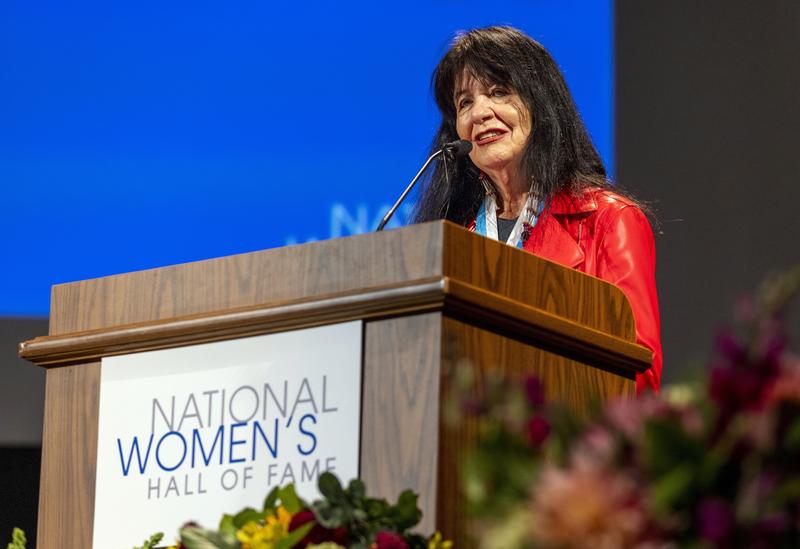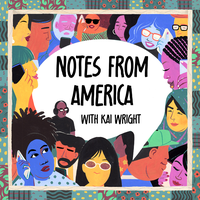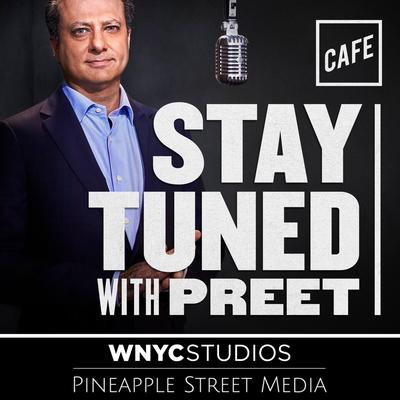Joy Harjo and Native Stories

( AP Photo/Lauren Petracca )
[theme music]
Kai Wright: It's Notes from America. I'm Kai Wright. Joy Harjo is a celebrated, multifaceted artist. She served as the 23rd US Poet Laureate and was the first Native American to hold that honor. She's the author of 10 books of poetry and produced seven award-winning music albums. Her life as an artist began as a child at one of the federal Indian boarding schools that for so many Indigenous families were a sight of pain and trauma.
For Joy Harjo, that history is more complicated. I spoke with her recently about her early years and about her newest project. She's just released an adaptation of her famous poem, Remember, as a children's book. The poem was one of the first Joy ever wrote almost 40 years ago. It invites readers to pause and reflect on the wonder of the world around us and our place in it. I began my conversation with Joy Harjo by asking her to read the poem.
Joy Harjo: This is the poem, Remember.
Remember the sky that you were born under,
know each of the star’s stories.
Remember the moon, know who she is.
Remember the sun’s birth at dawn,
that is the strongest point of time.
Remember sundown and the giving away to night.
Remember your birth, how your mother struggled
to give you form and breath.
You are evidence of her life, and her mother’s, and hers.
Remember your father, he is your life, also.
Remember the earth whose skin you are:
red earth, black earth, yellow earth, white earth,
brown earth, we are earth.
Remember the plants, trees, animal life who all have their
tribes, their families, their histories, too.
Talk to them, listen to them.
They are alive poems.
Remember the wind. Remember her voice.
She knows the origin of this universe.
Remember you are all people and all people are you.
Remember you are this universe and this universe is you.
Remember all is in motion, is growing, is you.
Remember.
Kai Wright: It's really wonderful. In your author's note for the new book, you share that in the Muscogee Nation tradition, you have poems for nearly everything. You write that, "To speak or to sing aloud or on paper is a powerful way to bring your thoughts, your yearnings, the most secret dreams of your heart into existence." What does this poem bring into existence for you?
Joy Harjo: Well, it brings into existence old knowledge that's always been here. I think if you go to the roots of cultures, we all have roots to cultures, Indigenous to either the Americas or Africa or Europe or Asia, et cetera. The basic tenants are often pretty much the same. This poem came about when I was just starting to write, actually. I had no plans to become a poet. I was on my way to being a painter and artist like some family members.
I came to realize, and this poem is part of that because a poem is a kind of teaching for me too as a very young poet coming up is that, this was important. This was at the root of these words and these admonishments, and these reminders are reminding me and us who we are and that we're part of everything, and also about the power of language to call into being. I'm grateful to the poem, and I realize it came into existence to not just help me, but to help many others.
Kai Wright: I think it's probably hard for people to understand you in a moment when you didn't know you were going to be a poet. Tell me more about that, about how you came to that realization.
Joy Harjo: It was a surprise to me because I was always the person that sat in the back and didn't say anything. I was not a word person. I loved language. I loved sound. I loved music, but at Career Day-- I don't even think we had Career Day, but we certainly were aware of careers. Being a poet doesn't really--
Kai Wright: Wasn't on the list? [laughs]
Joy Harjo: You never-- [laughs] Or a saxophone player, anything. That's usually not on the list of how to make a living in this world. I've come to realize, the way it happened is that I was a studio art major at the University of New Mexico but also very involved in Native rights, especially for our communities, and worked with Kiva Club, the Native student club with various local communities and helping them with their various challenges with, say, the uranium companies and coke companies and other things that we were dealing with as Native peoples in the '70s.
I came of age, so to speak, at a time when there was-- It's been called the Native American Renaissance, literary Renaissance, but I was right there when Leslie Marmon Silko was writing, and Simon Ortiz, the Acoma poet, and James Welch from Blackfeet, and Anne Waldman, Ishmael Reed came to town. He was very strong in asking the question and helping provide answers like, what is American literature? If we're all Americans, why aren't we included? I just started writing.
I came to realize that I needed to learn how to speak and I took something on that I had no idea that I had signed up for, was this thing called poetry. What it allowed me to do is to speak with images. What's always been exciting for me is learning something I didn't know and putting things together. It's like painting in that I was painting with words and with sensibility and also about what was going on with our people and in our community.
I didn't grow up reading literature like that, but when I heard these other Native people and I thought, "Wow, you can construct with language. You can construct these little word paintings that are from us, not from some guy in England, declaiming poetry or somebody in the northeast part of the United States." I love poetry, and I loved a lot of that poetry, but it always felt so far away.
Kai Wright: Declaiming poetry.
Joy Harjo: Yes, declaiming. Right. [laughs]
Kai Wright: In Joy's memoir, Crazy Brave, which was published in 2013, she describes the harrowing tale of her childhood and her young adult life. She has overcome a lot; familial abuse, teen pregnancy, abusive exes, and addictions. As a young person, when she discovered one of the federally-run boarding schools that have been a source of trauma for so many Native children, she actually chose to attend. That's because, first off, it got her out of a really bad situation at home but also because it was an art school.
Joy Harjo: I was a high school student at the Institute of American Indian Arts when it was a Bureau of Indian Affairs School of 8th to 12th grade and two years post-graduate. Well, I first read Native poetry there. Oh, what was his name? I can see him right now. Vincent Price used to give money for a Native student poetry anthology every year. That's where I first read Native poetry to students.
A lot of the students wrote poetry. Even I think got kicked out of my English class because I was writing limericks about the horrible class we were in and got put in my own class. That's where I first heard Native poetry. At that time, at the Institute of America Indian Arts, we also kind of were the point of emergence, our class, and in that time of IA and Indian art history, it was sort of called Renaissance.
I don't know that that word exactly fits because we weren't emerging, we'd been here, but it was a certain wave. Every generation has a kind of wave. They make a wave of understanding and art. Our generation, I guess, was a little noisy with our wave of art-making, so that also led to the poetry.
Kai Wright: It's Notes from America. We'll be right back.
[theme music]
Kai Wright: The US Department of Interior is now led by Secretary Deb Haaland, who's the first Native person to hold that position. She's launched a series of listening sessions in Native communities around the country to talk openly, for the first time, about the abuse that took place at these federally- run boarding schools like the one you attended. We've heard a lot about the trauma people still carry from that experience, but you're describing something quite different, something positive at least in part. What do you think was different for you about your experience?
Joy Harjo: That school that I went to had a history. It's gone back to being Santa Fe Indian School, and the Institute of American Indian Arts is now a college with even two tracks for MFA degrees run by Native people and so on. At that time, it was a Bureau of Indian Affairs School, but it was an unusual school because it came about to the vision of Lloyd Kiva New who saw how important the arts were. So many Native students were talented in art.
We had the old Bureau of Indian Affairs system in place where my detail, a lot of military language, my detail was getting up at 5:00 AM and helping in the kitchen of which I didn't mind because I had access to food. I had access to food, but that was part of that system is that we all had to work. We all had work. Another part of it though was we weren't allowed to speak our Native languages and we were punished for that. That was part of it.
The cool part was that-- What was different is that our education was primarily in the arts, and we had some of the finest artists in the country, mostly predominantly Native artists but also non-native artists. It was the first time I had Native teachers, and a lot of them very famous and very well-known, at the height of their careers producing art that we got to watch the process, as well as teaching us. That was pretty profound.
I believe that there was a moment where we were all coming together, young Native artists. What does it mean? What does it take to be an artist or a poet? It means that you watch and you listen beyond what everyone else is watching and listening to, to catch fresh ideas, to understand. I think our artists and poets are almost the antennas or the point people of culture. Being there, that was quite incredible to be there with those teachers. The academics were so-so, and that's why I got into trouble. I didn't think it was right.
The teacher brought in fourth-grade readers for all of us in 11th grade, and we had lives. We'd all seen a lot. A lot of us were there. We would have been home if we didn't have trouble and sent away to school. There was some of that old stuff in place. I remember we went out to help a student. She was punished by having to clean the sidewalk with a toothbrush that ran probably about a half mile along the side of the school.
Kai Wright: Good grief.
Joy Harjo: We all went out to help her and they wouldn't let us help her. There were moments like that, and some of us could hear the kids that had been dragged away from their families not long before crying. You could sometimes hear the children crying who had been there. I wound up in a class by myself for English and was told I could read whatever I wanted. Most of the books are what people had donated in town.
In a classroom, and I later taught in this classroom was the wall, was [unintelligible 00:13:57] by stoves. A few years before us, the female students were taught how to cook and clean for people in town, and those were still there.
Kai Wright: How to be a servant.
Joy Harjo: Yes, and there were still remnants of dairy barns out back to teach the boys how to be dairy farmers when most of us were lactose intolerant. [chuckles]
Kai Wright: I have to say, Joy, you're describing things that it's hard for me to then see the positive side that you point to, but as I take it, you're saying but the point is despite all of that, you were able to be surrounded by artists, and that was an important moment for you as a consequence.
Joy Harjo: Yes, because there's something about being-- We're wired a little differently, I think, to be an artist. To be there together, and you can imagine the trouble we caused together, we had…. but was exciting. I think being there helped form some of the basics as I went out into the world as a Native artist, to have that community, and we're still a community.
We keep coming up together in all of the iterations and shifts and history and culture that we embody and that we've gone through since our time together there in the late '60s at the Institute of American Indian Arts and being in Santa Fe too. We had some tremendous teachers there and mentors who really helped shape and form us, and are friends too. We also brought with us a lot of historical traumatic baggage, and a lot of people didn't make it.
Yes, the Indian's gone. I'm glad that Deb Haaland is doing that because how does a country heal or how does a place heal except that these stories need to be told? They need to be listened to. That's part of it. They need to be heard.
Kai Wright: For her new children's book, Joy Harjo collaborated with artist Michaela Goade, who created illustrations to accompany the poem, Remember. Michaela, who's a member of the Tlingit nation, brought her own heritage to the project. There are images of a raven which is essential to the Tlingit creation story that sweep across the pages of the book.
Joy Harjo: They really help give across that we are in a sacred circle, that this life in a sacred circle because this is a world of duality. There's the profane running right alongside, but there's dark, there's light, and there's the beauty.
Kai Wright: And perhaps in each of us.
Joy Harjo: Yes, with every one of us, or we wouldn't be here. We could not exist in this atmosphere if there wasn't.
Kai Wright: When a young person finishes this book, what would you hope they would take away from it? Is that an idea?
Joy Harjo: Yes, or what characterizes it? All through here are the animals and the people and the plants. I think if you look at each of the beautiful illustrations, you see everybody together. Yes, you have the young girl, the character going through the book, but she exists with the plants, with the water, the ocean, and the animals in the ocean, and the sun, and the moon, that we're all in this story.
We're all in this story together, and we're part of it. We're an essential part of it. Remember you're this universe and this universe is you, that you have a place, and so do the plants, and so do the animals. That's what I think is important. I think that's what is most important perhaps in the reading of this book.
Kai Wright: Joy Harjo, thank you so much for making time to tell us more about yourself and more about this wonderful work.
Joy Harjo: Thank you so much for speaking with me.
[theme music]
Kai Wright: Notes from America is a production of WNYC Studios. Follow us wherever you get your podcast and on Instagram @noteswithkai. Special thanks this week to our partners at KOSU in Oklahoma. We're working together on more episodes exploring the history of Indian boarding schools and the questions that history raises for right now, so stay tuned for more.
Mixing and theme music by Jared Paul. Matthew Marando was our live engineer this week. Reporting, editing, and producing by Karen Frillman, Vanessa Handy, Regina de Heer, Rahima Nasa, Kousha Navidar, and Lindsay Foster Thomas. André Robert Lee is our executive producer, and I am Kai Wright. Talk to you next time.
Copyright © 2023 New York Public Radio. All rights reserved. Visit our website terms of use at www.wnyc.org for further information.
New York Public Radio transcripts are created on a rush deadline, often by contractors. This text may not be in its final form and may be updated or revised in the future. Accuracy and availability may vary. The authoritative record of New York Public Radio’s programming is the audio record.





